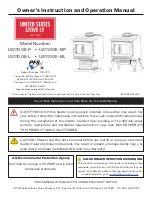
TLC 2000 Coal Stove
18
Caution: Always wear fire-resistant gloves to
operate the stove. The air control is hot while
in operation.
Installing to a Prefabricated Chimney
When venting your TLC 000 using a prefabricated
chimney, be sure to contact local building code authorities,
and to follow the manufacturer’s instructions
exactly
. Use
only the manufacturer’s parts; do not use makeshift installa-
tion techniques. All prefabricated chimneys must be tested
to either the U.S. or Canadian high-temperature standards,
UL 103 or ULC-69.
Warning: Do not install in sleeping room.
The Harman TLC 000 was tested with the fuel door
open and closed.
If you operate with the door open, open the by-pass and
put a screen over the opening.
Do not burn any fuel other those specified. Other sloid
fuels, such as charcoal, can cause increased carbon mon-
oxide production or overfiring. Never use highly volatile
substances in your stove, such as gasoline, which could
cause an explosion.
When solid fuels are burned completely, they produce
water and carbon dioxide. However, in long slow burns, a
substantial amount of carbon monoxide may be produced.
If allowed to build up, carbon monoxide (which is odorless)
can prove fatally poisonous. Proper ventilation and draft
will prevent this from happening. If you smell smoke, turn
up the air control lever setting, and thoroughly ventilate your
dwelling. During future burns, be careful not to overload
the stove with fuel, so you will not be tempted to constantly
operate at a low air control setting.
Other causes of poor ventilation or draft are icing, ex-
haust fans, a blocked outside air inlet, and room air starva-
tion. If your stove is sluggish and you get occasional odor,
check these possibilities and increase the air flow in your
home.







































